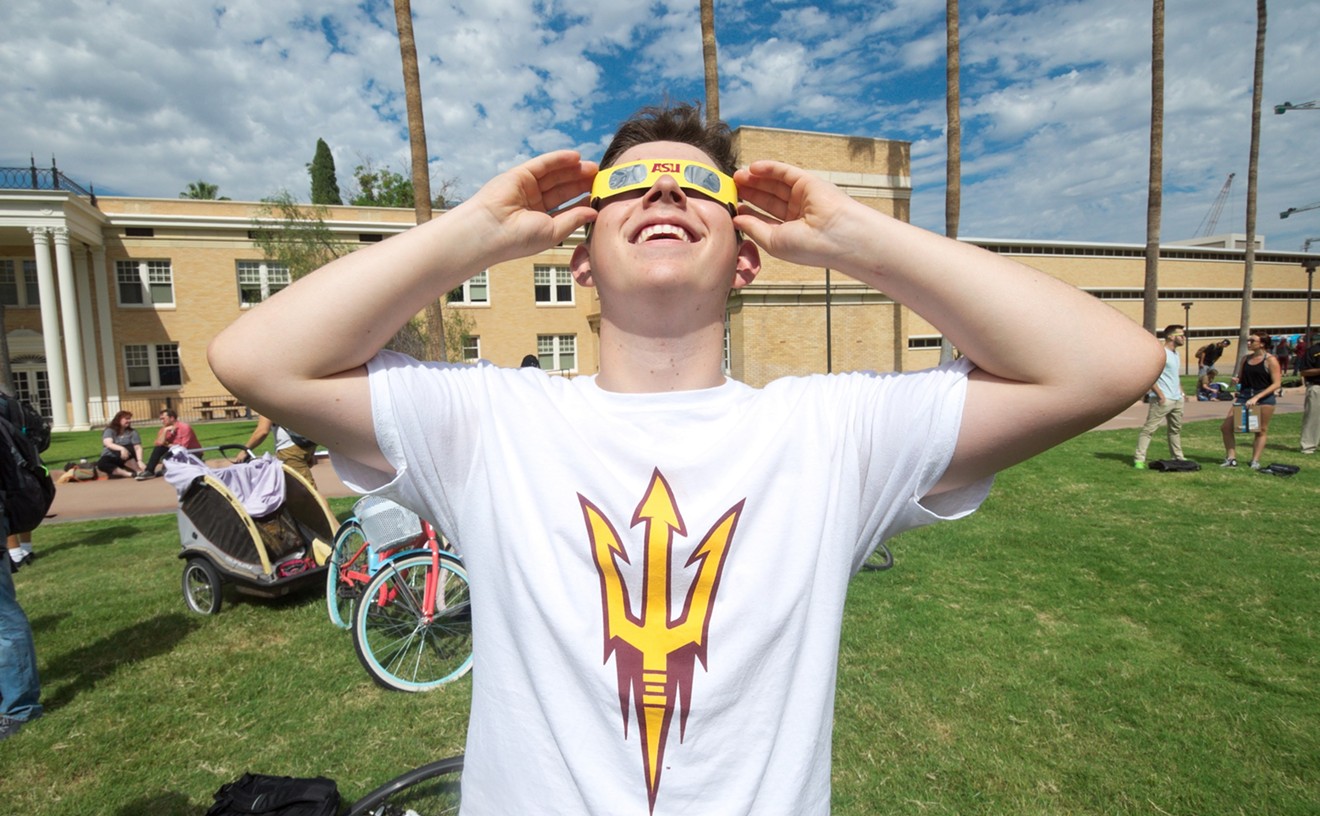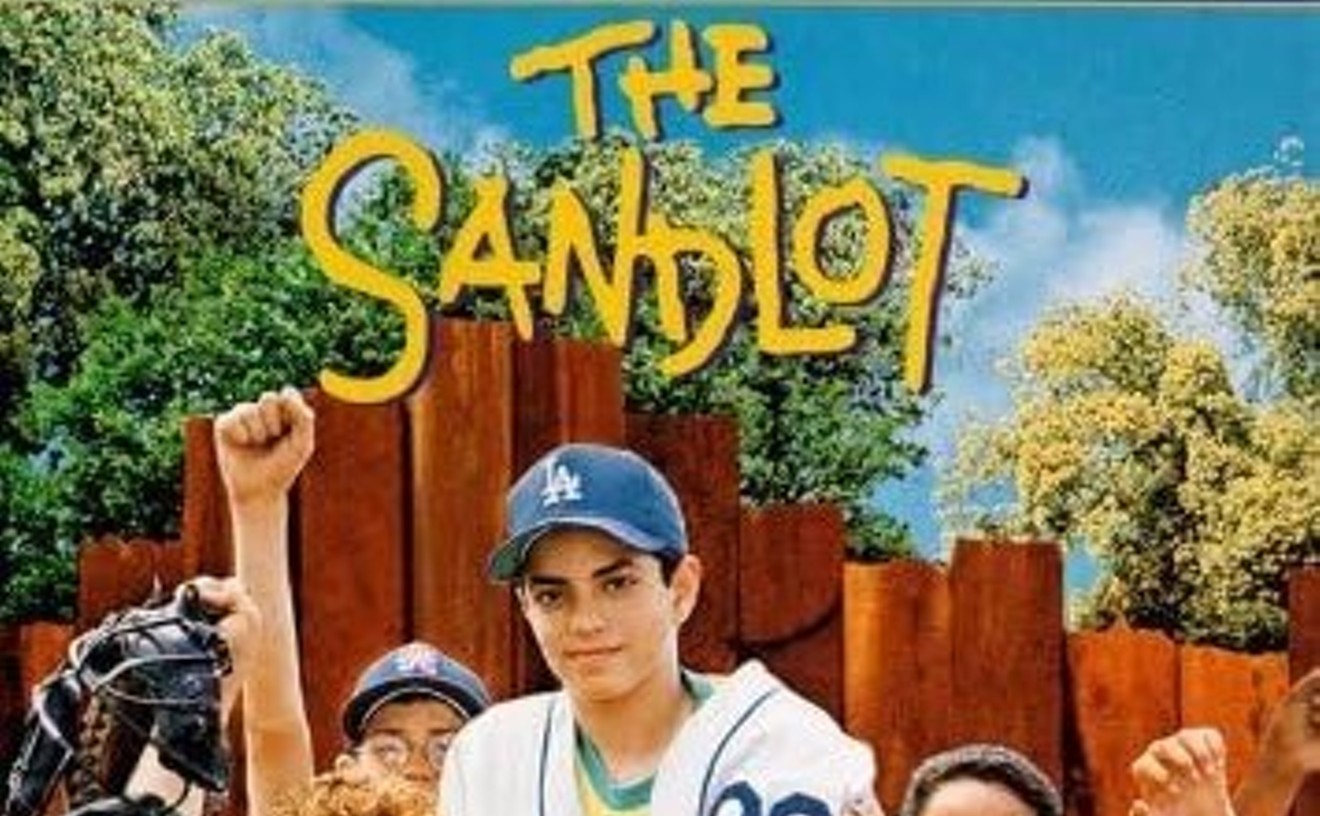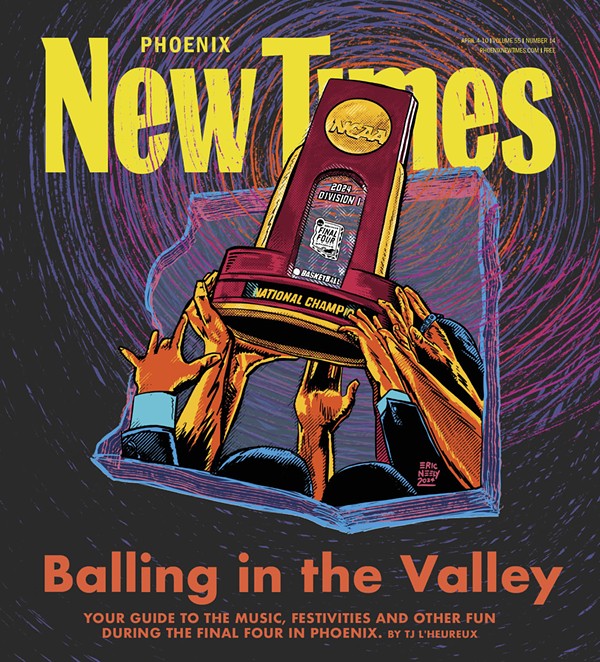Long before it was fashionable (or commercially profitable), interdisciplinary artist Angela Ellsworth must have consulted some seer stones before she decided to focus on her well-rooted Mormon ancestry as subject matter for her art.
Seer stones, for the uninitiated, are rocks with holes in them imbued, with special powers. Such stones were said to have been used by Joseph Smith, the founder of the Church of Jesus Christ of Latter-day Saints (commonly referred to as the Mormon Church) in the 1800s. Smith, a hardcore polygamist who eventually collected 35 wives, first used them to locate lost objects and hidden treasure (mostly without success). Later, he called upon their power to translate the cryptic Book of Mormon, the sacred scripture of Mormonism engraved on golden plates, from "reformed Egyptian" into understandable English.
In a case of life imitating art imitating life, several years after Ellsworth dug into making her early Mormon, polygamy-inspired work, Hollywood spawned not one but two television series based on just this subject — Big Love, a pithy HBO drama series about fictional modern-day practitioners of polygamy, long illegal in the U.S., and Sister Wives, a reality show that premièred on TLC September 26, featuring an actual fundamentalist Mormon salesman from Lehi, Utah, with four wives (one legal and three others not so much) and 13 kids.
But it won't take magical seer stones or television shows to assist even non-art lovers in fully appreciating Ellsworth's most recent body of work, which directly confronts issues of the lives of Mormon women pioneers, polygamy, forced communal domesticity, and a look at sister wives through a homo-social lens. Ellsworth went international with her latest creations at the 17th Biennale of Sydney, a by-invitation-only art exhibition held in Australia's capital city every two years. Now an entire world has come under the sway of solemn sister wives doing the Electric Slide in pastel prairie dresses, hairdos with frontal poufs, and strap-on braids.
A month-long love fest of art that took over almost every major cultural institution in Australia's largest city between May 12 and August 1 of this year, the sprawling 17th Biennale of Sydney, rather poetically titled "The Beauty of Distance: Songs of Survival in a Precarious Age," was a high-visibility showcase for art centered on issues of cultural diversity, plurality, and coping mechanisms in an increasingly homogenized world where distances of all types shrink daily. The main aim of this year's exhibition, according to the Biennale's English curator David Elliot, was to bring together different art forms from diverse, though not necessarily mainstream cultures on what he calls in an official Biennale document "the equal playing field of contemporary art, where no culture can assume superiority over any other."
Of 10 American artists, out of an overall total of 166 invited to show work there, three happened to be represented by Lisa Sette Gallery on Scottsdale's Marshall Way. Statistically speaking, that's a huge chunk of Arizona-connected artists, all of whom have ties to ASU Art Museum and the university, in general.
Mexican-born and -bred Enrique Chagoya, 57, no stranger to border culture on both sides of the proposed fence, whose irreverent work is part of Arizona State University Art Museum's permanent collection, and up-and-coming Claudio Dicochea, 29, also Mexican by birth and a recent recipient of a master of fine arts degree from ASU, are two of this holy ASUAM-related art trinity. The third member of the Biennale triad is 46-year-old Angela Ellsworth, currently an assistant professor of intermedia in ASU's Herberger Institute for Design and the Arts, who works in drawing, performance, and sculptural installation.
By dint of their selection, all three artists have achieved star status back home, seemingly overnight — though, in reality, all have worked ceaselessly at their craft for years.
Given the idealized Biennale theme of cultural diversity, it's hard to escape the irony attached to these three artists having a major presence in Arizona. It's the ignoble birthplace of SB 1070, a divisive anti-immigration statute that may or may not be upheld, ultimately, by the U.S. Supreme Court, not to mention a bastion of legally sanctioned anti-gay-marriage sentiment instrumental in passing Proposition 8, California's one man/one woman marriage initiative, in 2008.
Though the work of Chagoya and Dicochea, which deals with issues of immigration, border culture, and racial mixing, is powerful, it's Ellsworth's art that seems to have unwittingly captured the attention of not only Biennale attendees, but local art mavens as well. "My work is all about ancestors," Ellsworth told a packed audience at ASUAM during a September panel discussion centered on the Biennale. "I've had issues with this history most of my life."
That history includes being raised Mormon. It also includes the fact that Ellsworth is the great-great-granddaughter of Lorenzo Snow, Mormon prophet, the fifth president of the Church of Jesus Christ of Latter-day Saints, and husband to 12 wives (two of whom were biological sisters). As a prophet in the Mormon Church, Snow was considered to be a visionary or seer capable of receiving divine revelations related to church doctrine. A contemporary of Joseph Smith, Lorenzo Snow was convicted and imprisoned on three counts of unlawful cohabitation in 1885 under the 1852 Edmonds Act, a federal statute outlawing polygamy. The U.S. Supreme Court eventually ordered his release, saying that Snow's three offenses were actually one "continuing offense," a term pointedly referred to in the title of Ellsworth's sculptural installation for the Sydney Biennale.
The artist admits that "[f]or 15 years, I never talked about how I was raised or where I was raised and moved along with my life, bypassing a huge chunk of my formative years. Looking at this history now, I've started to move beyond the anger against the restricted and oppressive place that I felt within [the Mormon structure], and I feel like I'm looking at this history, particularly polygamy, and how contemporary Mormons want to separate themselves from that history."
Things get even more intriguing when it's revealed that Ellsworth, no longer a practicing Mormon, is an acknowledged lesbian in a committed, long-term marital relationship with Tania Katan, a writer, playwright, and actress currently performing in a one-woman show called Saving Tania's Privates. As a direct descendant of a Mormon prophet, Ellsworth is to be revered, but, notes Ellsworth, the fact that she's openly gay has worked against her as far as the Mormon Church is concerned. "BYU [Brigham Young University in Salt Lake City] invited me to be a visiting artist there but revoked the invitation when they found out I'm queer."
The homemade sunbonnets worn by 19th-century Mormon women, slowly trudging on foot as they pulled white oak handcarts through the inhospitable American wilderness, stand as the basic inspiration for Angela Ellsworth's "Seer Bonnets: A Continuing Offense," a sequel to related work first shown during "Underpinnings" at Lisa Sette Gallery in February 2009.
Her multimedia installation appeared in the main gallery of Sydney's Museum of Contemporary Art, a coveted spot by any standards. It incorporated 12 handmade fabric bonnets — each of which represented one of her great-great-grandfather's wives — encrusted with thousands of old-time pearl-headed corsage pins and embellished with mysterious monochromatic patterns. Each bonnet was mounted on a custom-made, unfinished white oak pedestal that references the carts of the artist's Mormon pioneer ancestors.
"The pedestals of white oak were a pain to get into Australia because wood is a real problem [as a carrier for insects]," says the artist. "I was committed to making them out of white oak, which is what early Mormon pioneers all made their handcarts out of. There's no white oak in Australia, so we had to go through fumigating all those things."
Ellsworth's seer bonnets are not only patterned after the traditional pioneer bonnets that many Mormon colonizers wore, but are also exactly like ones used for Mormon Corridor history walks, historical reenactments that Mormon youth still undertake in high school and junior high. "They pull handcarts for three days," she says. "You can't eat for 12 hours — it's sort of durational. My mom wouldn't let me do it. I must have incorporated that in my own work, since I wasn't allowed to do it as a kid."
Ellsworth's pearl-laden bonnets are prickly in every sense of the word; though beautifully decorated on the outside, their reverse sides wickedly bristle with sharp, shimmering pinpoints. A devoted team of local volunteers, working alongside the artist over a period of months in her Phoenix studio, helped push between 19,000 and 22,000 pins into each bonnet, depending on the length of their exaggerated ties, most of which were around 70 inches long. During pin-pushing sessions, bonnets were referred to by the names of Snow's wives. Pins used to embellish them were purchased from a floral supply distributor in Arizona.
According to Ellsworth, the circular designs on each bonnet allude to Smith's visionary seer stones. She sees them as spiritual portals for their female wearers to access their own visionary powers: "The circles [are] my idea of giving the women wearing the bonnets their own visions and the possibility of seeing and translating things."
Those arcane designs could just as easily reference Masonic symbols — commonly attributed in many religious quarters to the occult — found on LDS temples and incorporated into the church's iconographic lexicon to this day. Joseph Smith, together with many of his church members, was a Freemason and, early on, adopted the secret society's symbols for liturgical and architectural use.
Ellsworth's Australian sculptural display was amplified by a performance piece she created to accompany her static art objects. Meanwhile, back at the ranch (2010) featured her mini-army of sister wives, who made their inaugural appearance in Compounded (2009) at Sette's "Underpinnings" opening and, later, performed in Chicago. In Sydney, they appeared on a number of occasions in the same gallery as the seer bonnets. Dressed similarly to women members of the Fundamentalist Church of Jesus Christ of Latter-day Saints (FLDS), a breakaway Mormon sect still practicing polygamy, Ellsworth's unmistakable crew of young women in athletic shoes were clad in ankle-length granny dresses in a rainbow of soft hues, sporting distinctive frontal hair poufs with single braids snaking down their backs.
The FLDS first came to national attention in 2008 with the arrest of polygamist FLDS leader Warren Jeffs (who specifically outlawed patterned fabric and the color red for his female followers). The artist told New Times that she initially ordered the plain Jane prairie dresses in 2008 directly from a fundraising FLDS website that has since closed, forcing her to find a local seamstress to replicate the dresses.
Looking as if they had just escaped from Little House on the Prairie, the Sydney sister wives silently entered the museum space en masse. Then, without any musical accompaniment, they would break into either the Electric Slide, a line dance first made popular in the U.S. during the '70s and still danced at family and coming-of-age events, or a couples' Sweetheart Dance. The performance crew included three ASU grad students, whose trips to the Biennale were paid for by the Herberger Institute. The three performed and also trained Australian volunteers for Ellsworth's performance. As a break between dances, the sister wives wandered through the gallery, sending unchoreographed, wordless communications to one another through touching both each other, themselves, and the architecture of the building.
Ellsworth says her interest in and research of group dancing was born at Cash Inn Country, a lesbian cowboy bar on McDowell Road and 20th Street, where she learned to line dance on Thursday nights.
Though she's been variously described as a life-size Kewpie doll and a delicate, porcelain-skinned lady who looks as though she would blush at the sound of a dirty word, Angela Ellsworth is no shrinking violet. And she's definitely never shied away from sticky personal and social issues in her work. A high-profile part of the Valley art scene for more than a decade, Ellsworth is mostly known for her groundbreaking performances, which tromp fearlessly through thorny psychological terrain, even though she was trained as a painter.
After earning a B.A. in fine arts from Hampshire College in Amherst, Massachusetts, and an M.F.A. in painting and performance from Mason Gross School of the Arts at Rutgers University in New Jersey, in the early 1990s, the artist was creating large, thickly painted canvases revolving around the idea of the female body — more specifically her own, with attendant personal issues of self-worth, weight, eating, skewed self-image, and stereotypes of beauty pushed in contemporary American culture. Thereafter followed Misfit Attire, a performance piece in a burned-out building in New Jersey, during which Ellsworth sucked out the cream filling from some 100 pink Hostess Snowballs, which she was forbidden to eat as a child, stuffing the cake parts into one of the legs of black fishnet stockings she was wearing. While doing that, her performance partner, Tina Takemoto, was sharpening chopsticks with an electric pencil sharpener strategically placed in her hair, which she then stabbed into her dress to create a porcupine effect.
In 1993, Ellsworth was diagnosed with Hodgkin's lymphoma, a form of cancer originating in the body's white blood cells. After her diagnosis and during her cancer treatment, the thrust of her work, in partnership with her close friend Takemoto, was aimed at dealing with her psychologically devastating battle with cancer, chemotherapy, insurance coverage, and alternative medical therapies. Thus was born Caffeine and Carotene.
In an unforgettable appearance at downtown Phoenix's Icehouse in 1997, Ellsworth and Takemoto took over the Cathedral Room, constructing a scaffold contraption several stories high that featured a juicer attached to an exercise bicycle, yards of medical tubing, and coffee. For four hours a day over a three-day period, the duo engaged in a Kafka-esque ritual of juicing 900 pounds of carrots via furious bicycle pedaling, after which they bagged and labeled IV bags filled with the resultant combo of juice and coffee, then stuffed carrot remains in bags stamped "pre-existing condition."
That same year, for the opening of ASU Art Museum's "Art on the Edge of Fashion," Ellsworth ensconced herself in one of the stalls of the museum's downstairs ladies restroom. Sitting on a toilet, she ate powdered donuts and whispered stories about body size and mass, which murmurings were piped into the men's restroom, as museum-goers in the women's room peeped through the cracks of her stall or peered into periscopes focused on her. For ASUAM's 1997 "Token City," a multi-media exhibition creating a virtual subway experience, Ellsworth unabashedly re-created the distinctive smell of a big city subway by soaking a cocktail dress in her own urine for a full week, drying it, then wearing it at the show's opening, while fanning herself under hot gallery spotlights with a fan marked "Actual Odor," the name of her performance piece.
In 1998, as part of that year's Art Detour, Ellsworth mounted Hemaderby in the Icehouse's enormous Silver Room. For two days, six hours each day, Ellsworth created her own version of the circulatory system in a roller derby setting. Dressed in a glittery ball gown, skates, and a mirrored helmet attached to the ceiling that restricted her movement, the artist made like a lymph node, while other mirror-helmeted skaters, representing red and white blood cells and platelets, moved around her under dramatic colored lights.
Around the time of her Hemaderby performance at the Icehouse, Ellsworth, along with Leslie Hill and Helen Paris, founded Live Art Platform (LAP), a Phoenix-based nonprofit arts group dedicated to performative artwork responsible for a spate of body-based works at Valley venues, including Ellsworth and Takemoto's Squeak and Clean in November of 1999 at the now-defunct but extraordinarily hip Barlow and Straker Gallery. During that feat of endurance, a perfectly coiffed Ellsworth was running on what apeared to be a Nordic Track encased in a large exercise ball, while Takemoto, covered in climbing gear, was scaling a wall in the gallery's back room, all the while drawing on the walls with her feet among exercise balls suspended from the ceiling. On the floor beneath who were 1950s-era handheld massagers attached to large bars of soap, which connected to tubes in Ellsworth's steamy ball prison.
In 2000, ASU Art Museum hosted another Ellsworth performance called "Club Extra," during which the artist took on twisted concepts of beauty, health, fitness, and art museums. For the opening, Ellsworth was transformed into Angie, Club Extra's terminally perky fitness coordinator. In the early 2000s, the artist eventually left Phoenix "for love," moving to L.A. and hooking up with the L.A. Art Girls, a well-known female artists collaborative, but returned to the Valley several years later, where she continued staging singular performances with her trademark sense of existential endurance.
Turning her attention momentarily from fat, cancer, and bodily fluids, Angela Ellsworth has, in recent years, thematically mined the mother lode of her Mormon heritage and how it relates to issues raised by her acknowledged homosexuality. She likens recent polygamy prosecutions of FLDS members to the continuing stigmatization of same-sex marriages, which at present are, not unlike polygamy, still prohibited by law in most of the United States.
"I'm interested in the non-hetero-normative relationships in both queer culture and in polygamy," Ellsworth told her rapt ASUAM audience. "And I want to talk about it. These are very contemporary issues, all complicated by a general fear of anything that's outside of a hetero-normative frame. For me, that's underneath all of it."










